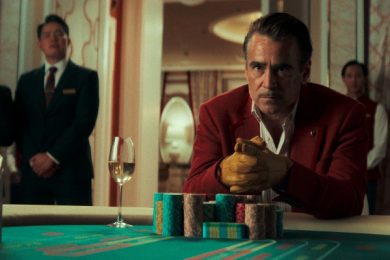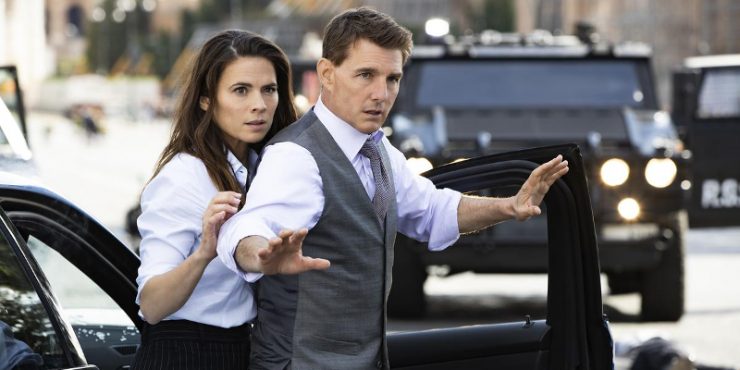Tom Cruise’s dedication to the movies is such that appreciating his films goes hand-to-hand with appreciating said dedication simultaneously. The grandiosity of his ego means that his endless commitment to his films cannot go unnoticed. Cruise is far from the only one (see: Vin Diesel’s insistence on being the permanent lead ambassador to the Fast and the Furious franchise, assuming all credit for the serie’s success for himself), and the whole spectacle is a nod to a certain kind of movie star that doesn’t really exist anymore. And that is what Cruise is truly fighting for: the legacy of true movie stardom; the ability to lead a film – to lead Hollywood – with the power of your screen presence. If Cruise weren’t the best in the world at it, it might get to be a bit cloying. But because he is the greatest movie star of his generation, his latest film is yet another testament to his longevity and his star wattage.
The world salad of the title – Mission: Impossible – Dead Reckoning, Part One, a mish-mash of generic expressions amongst a sea of punctuation – is not the only extensive part of the movie. Reckoning hovers tenuously close to three hours, was filmed on location in Rome, Venice, London, the Swiss Alps (to name a few), and is reported to have been one of the most expensive movies ever produced. Now, the robust budget could probably be blamed on several COVID-19 related delays in 2020, but all that aside, it can’t be argued that Dead Reckoning looks expensive. In an age where Marvel and several big market streamers are spending hundreds of millions of dollars to make films that look like green-screen slop, there is nothing more refreshing than a Mission: Impossible film, which sets the filmmaking standard for itself so high, and clears it nearly every time.
The last Mission: Impossible film, 2018’s Fallout, is probably one of the greatest action films of the last fifty years, an achievement that Dead Reckoning could hardly expect to live up to. The series has evolved from the noirish sensuality of the first film in 1996, directed by Brian De Palma, to the asexual blockbusters established by 2015’s Rogue Nation, directed by Christopher McQuarrie. Dead Reckoning is the third consecutive Mission film that McQuarrie has directed, though this latest entry has a delightful amount of Easter eggs relating to De Palma’s original. At this point in the game, Cruise and McQuarrie are interested in tracking the full arc of Ethan Hunt and his IMF team, perhaps leading to a proper send-off for America’s favorite super secret agent (a rumor that both McQuarrie and Cruise have swatted away).
There is always a huge conspiracy, and Ethan Hunt is always fighting for the stability of a government that is quick to disavow him. Over the course of the series, Hunt’s villains have gotten bigger and more abstract. We’ve gone from individual terrorists to The Syndicate and, now, The Entity. As described in the first act of Dead Reckoning, The Entity is a faceless algorithm collected by a submarine underneath the arctic core which has uploaded all sensitive intelligence information across the world. When that submarine is shot down and sitting at the very bottom of the deepest ocean, an arms race begins between various good and bad guys to get the two halves of the key that can control it. For the entirety of Dead Reckoning, Hunt doesn’t even know what the Entity is capable of. He just knows it’s too powerful for any one man or institution to have, so he decides to find the key himself and destroy it.
There’s something symbolic about the nebulousness of The Entity, as if Cruise’s Hunt has exterminated all of his flesh-and-blood adversaries and is left with a matter-less ghost with the power of God (no joke, the key is shaped like a cross). It’s not dissimilar from the state-less enemy of last year’s Top Gun: Maverick, an otherwise great movie that envisions the American military as an apolitical moral police squad. We can’t seem to envision actual men who can take on Cruise, so we’re settling for a computer virus. There is the character of Gabriel (Esai Morales), a cold-hearted killer from Ethan’s past who has arisen as his main competition for finding The Entity. We’re given glimpses of Gabriel’s role in various tragedies in Ethan’s life, but the full extent (I hope) appears to be left for Part Two.
Most of the movie, Hunt hangs out with old friends, including Ilsa Faust (Rebecca Ferguson), who he finds in the middle of the Arabian dessert with one half of the key. He then ends up in the Abu Dhabi airport with his usual crew: computer hacker extraordinaire Luther (Ving Rhames) and the high-strung but resourceful Benji (Simon Pegg). As they search to find the man who has the other half of the key, they encounter Grace (Hayley Atwell), a high-priced thief who is also after the key, hired by an unknown but wealthy buyer. Grace is a classic in-over-her-head woman who walks into a danger that only Ethan Hunt can get her out of. But Atwell’s Grace proves more interesting than the usual Mission: Impossible damsel in distress, frequently working her way out of Hunt’s grasp, desperate for the independence that a professional thief’s life can bring.
Even as Gabriel and his main henchman – a striking but deadly French assassin named Paris (Pom Klementieff) – approach with deadly force, Grace still does everything she can to slip from Ethan’s paternal control. It’s not until they’re cornered in a bustling Venetian night club that the real stakes emerge: the White Widow (Vanessa Kirby returning for her Fallout role) is brokering a deal for Gabriel to get the key, while Gabriel has orchestrated an elaborate scheme to force Ethan to choose between the people that he loves most. Spread throughout the drip-drip of plot, are extraordinary action set pieces, including a high-octane car chase through Rome, a truly show-stopping sequence aboard a train heading toward a blown-out bridge, and a much-balleyhooed shot of Hunt riding his motorcycle off the edge of a mountain cliff.
Cruise in complete Hunt mode here, mission-focused and uninterested in emotional depth. Compared to Maverick or even Fallout, Cruise gets less space to showcase his vulnerability and his (frankly, at this point, underrated) acting chops, with all the oxygen taken up by his suicidal kink for death-defying stunts. Atwell’s inclusion in the film also highlights Cruise’s fixation for button-nosed brunettes, as the franchise’s stable of female characters grows bigger but begins to develop some redundancies. Much like Across the Spider-Verse, the movie is burdened with the set-up of its successor. Both films fill heavily with some of the most breathtaking visual spectacle possible in the movies, but both are also probably too long and struggle to come up with a villain of any substance (in both cases, figuratively and literally).
Dead Reckoning still fulfills its obligations to the audience, and some of the filmmaking ranks amongst the best in the series, but it does fall short of the triumph of Mission: Impossible‘s best films. Cruise has been almost dogmatic for the last few years in his love of cinema, and that effusiveness shows itself throughout Dead Reckoning‘s thrilling action sequences. You will get your fill, you will get sufficiently excited for the upcoming part two, but most importantly, you will leave convinced in Cruise’s continued dominance of the silver screen. The king of serving the audience by serving himself makes another film that proves that that’s a good thing, actually.
Directed by Christopher McQuarrie










